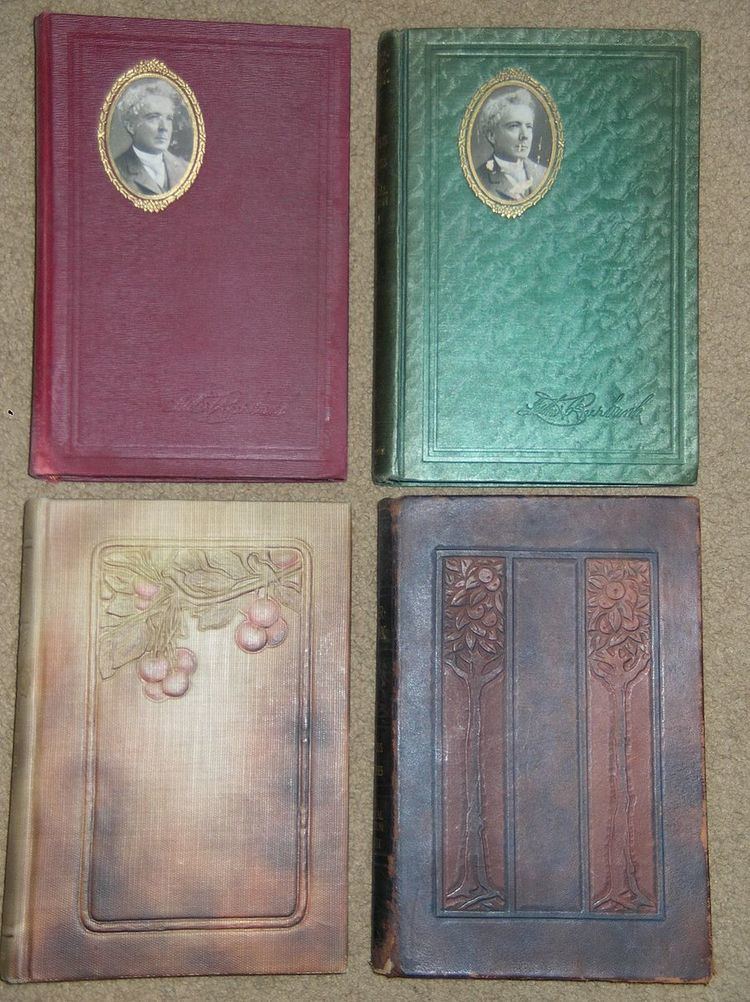 | ||
Similar Luther Burbank, How plants are trained to work fo, The harvest of the years, The Training of the Huma, The Variation of Animals a | ||
Luther Burbank: His Methods and Discoveries, Their Practical Application is one of the first sets of books published using color photography and is the most-extensive publication of the work of Luther Burbank (1849–1926).
Contents
Luther Burbank history
Luther Burbank: His Methods and Discoveries is a twelve-volume set published by the Luther Burbank Press in 1914 and 1915. The set was sold by subscription.
Each volume has 105 color photographs tipped in, for a total of 1260 photographs. The photos provide an extensive record of Burbank’s work in Santa Rosa and Sebastopol from 1875 to 1914.
The books apparently had at least six writers including Oscan Binner, Edward J. Wickson and Henry Smith Williams, M.D., LL.D. George Shull reported that “considerable sections are most word for word the same as my manuscript.” Further, Shull found the text wanting: "It appears to me a criminal waste of good paper... The colored plates will prove both interesting and valuable."
Production
Sold by subscription, three quality levels of binding were offered: simple cloth, embossed cloth and leather.
The simple-cloth-bound edition was offered in multiple colors: red, blue, green and gold. Each volume has a black & white photo of Burbank inserted in the front of each cover. The books sold for $180 per set, “when $180 represented the earnings of two months’ work or longer.”
In the same format as the simple-cloth-bound edition, a suede leather version was offered. The leather was light in weight and not nearly as sturdy as the full leather editions, below.
The embossed-cloth edition has a cherry design.
The leather-bound edition has a two-tree design with tall trees in panels separated by a blank panel on the front covers. The first volume is endorsed to its buyer and has an original signature of Luther Burbank.
An unusual leather-bound edition with a path scene with stone posts, a gate and trees on along the paths the covers was used for presentation purposes. These sets do not have the Luther Burbank signature.
Another unusual leather-bound edition has a grape vine with grapes on a T-trellis on the covers. These have very heavy (wood?) boards.
Special paper was prepared for the volumes which was watermarked “The Luther Burbank Press.”
Color photography
The volumes are one of the first uses of color photography and color printing. Since a nationwide search failed to find suitable color printing technology, The Luther Burbank Press set up a photo-chemical laboratory using the process of Lumiere of Paris. The last volume has a section which describes how color photography and color printing is accomplished.
Chapters
The twelve volumes are
How Plants are Trained to Work for Man
How Plants are Trained to Work for Man by Luther Burbank, Sc.D published in 1921 is clearly a rework of the 1914–1915 work.
The 1921 publication is in eight volumes in a single binding. Each volume contains 49 photographs printed on separate pages, not the tipped-in photos of the original.
Despite Burbank's claim that, "these eight volumes are not a compilation from the works or words of others," the books cite the copyrights from 1914 and 1915 from the Luther Burbank Company.
All but two of the photographs in the 1921 volumes came from the 1914–1915 volumes. Generally, photographs in the first volumes of the early set are found in the first volumes of the later set, with this trend continuing to the last volumes.
The "Sc.D" is from the honorary doctor of science degree awarded Burbank by Tufts University in 1905.
